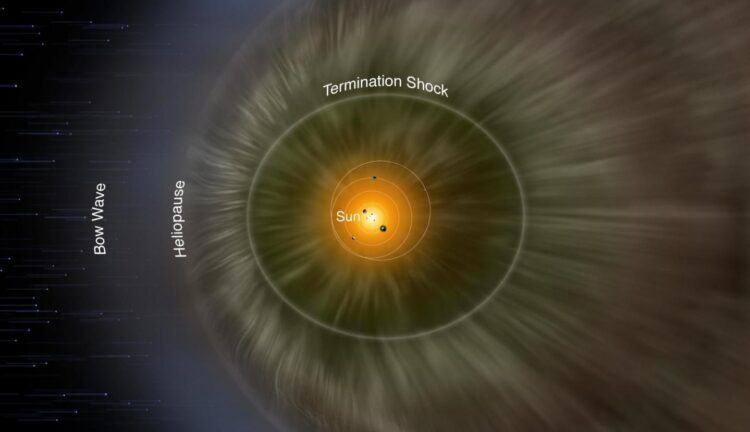Using data from NASA’s IBEX satellite, scientists created the first-ever 3D map of the boundary between our solar system and interstellar space
Los Alamos, N.M., June 10, 2021 – For the first time, the boundary of the heliosphere has been mapped, giving scientists a better understanding of how solar and interstellar winds interact.
Video link: https:/
“Physics models have theorized this boundary for years,” said Dan Reisenfeld, a scientist at Los Alamos National Laboratory and lead author on the paper, which was published in the Astrophysical Journal today. “But this is the first time we’ve actually been able to measure it and make a three-dimensional map of it.”
The heliosphere is a bubble created by the solar wind, a stream of mostly protons, electrons, and alpha particles that extends from the Sun into interstellar space and protects the Earth from harmful interstellar radiation.
Reisenfeld and a team of other scientists used data from NASA’s Earth-orbiting Interstellar Boundary Explorer (IBEX) satellite, which detects particles that come from the heliosheath, the boundary layer between the solar system and interstellar space. The team was able to map the edge of this zone — a region called the heliopause. Here, the solar wind, which pushes out toward interstellar space, collides with the interstellar wind, which pushes in towards the Sun.
To do this measurement, they used a technique similar to how bats use sonar. “Just as bats send out sonar pulses in every direction and use the return signal to create a mental map of their surroundings, we used the Sun’s solar wind, which goes out in all directions, to create a map of the heliosphere,” said Reisenfeld.
They did this by using IBEX satellite’s measurement of energetic neutral atoms (ENAs) that result from collisions between solar wind particles and those from the interstellar wind. The intensity of that signal depends on the intensity of the solar wind that strikes the heliosheath. When a wave hits the sheath, the ENA count goes up and IBEX can detect it.
“The solar wind ‘signal’ sent out by the Sun varies in strength, forming a unique pattern,” explained Reisenfeld. “IBEX will see that same pattern in the returning ENA signal, two to six years later, depending on ENA energy and the direction IBEX is looking through the heliosphere. This time difference is how we found the distance to the ENA-source region in a particular direction.”
They then applied this method to build the three-dimensional map, using data collected over a complete solar cycle, from 2009 through 2019.
“In doing this, we are able to see the boundary of the heliosphere in the same way a bat uses sonar to ‘see’ the walls of a cave,” he added.
The reason it takes so long for the signal to return to IBEX is because of the vast distances involved. Distances in the solar system are measured in astronomical units (AU) where 1 AU is the distance from the Earth to the Sun. Reisenfeld’s map shows that the minimum distance from the Sun to the heliopause is about 120 AU in the direction facing the interstellar wind, and in the opposite direction, it extends at least 350 AU, which is the distance limit of the sounding technique. For reference, the orbit of Neptune is about 60 AU across.
###
Paper: Reisenfeld et al., 10 June 2021, Astrophysical Journal, The American Astronomical Society.
DOI: 10.3847/1538-4365/abf658
About Los Alamos National Laboratory (http://www.
Los Alamos National Laboratory, a multidisciplinary research institution engaged in strategic science on behalf of national security, is managed by Triad, a public service oriented, national security science organization equally owned by its three founding members: Battelle Memorial Institute (Battelle), the Texas A&M University System (TAMUS), and the Regents of the University of California (UC) for the Department of Energy’s National Nuclear Security Administration.
Los Alamos enhances national security by ensuring the safety and reliability of the U.S. nuclear stockpile, developing technologies to reduce threats from weapons of mass destruction, and solving problems related to energy, environment, infrastructure, health, and global security concerns.
LA-UR-21-24901
Media Contact
Laura Mullane
[email protected]
Original Source
https:/
Related Journal Article
http://dx.





